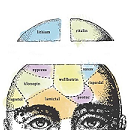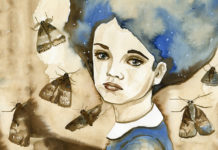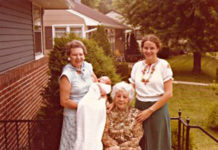Content warning: this story contains graphic details of self-injury and suicide.
When Polly left home, she wore a straitjacket over a light cotton housedress of pale yellow scattered with wildflowers. She liked to wear that dress around the house, with her black penny loafers and white ankle socks, but she never wore it outside, at least not beyond the backyard.
My mother wore that dress when she disappeared from my life for the first time shortly after my second birthday. I don’t remember, but my grandmother Doris deemed her daughter unfit to her homemaker responsibilities. Maybe Doris blamed Polly’s out-of-wedlock pregnancy. Or her ne’er-do-well Italian-immigrant husband. The isolated wreck of a duplex Polly called home. Maybe she didn’t ponder why before dumping my mother at Harlem Valley Insane Asylum.

I imagine Polly’s dress like a glimmer of sunshine between the two men dressed in white who led her down the front steps. She moved like a sleepwalker across the concrete path and into the waiting sedan. Her gait was clumsy, as if the ground shifted under her feet or something was broken. The car door stood open, and one of the men put his hand on her head to guide her into the back. He lay her black winter coat beside her and closed the door.
She didn’t look back. She didn’t say a word or wave. I suspect she worried the hand on her head had mussed her dark hair and wanted to pat it back into place—to make certain her bangs were straight and the flip curled evenly, right at the bottom of her ears—but she couldn’t. The straitjacket bound her tight.
I can almost see the three of them driving north through the hamlets of Carmel, Patterson, Pawling, driving carefully on narrow roads slick with black ice. The men likely spoke softly at first, maybe cracked a joke, and then fell silent, their faces green in the glow of the instrument panel as dusk settled fast and early on those winding, tree-shrouded lanes. The woods swallowed the headlights that swept the trees, burning a negative image on the men’s brains. Now and again a gust stirred sere branches, and an avalanche crashed to the ground, burying the tracks of animals seeking food in the sheltered thickets.
The drive to the sprawling complex of brick buildings that formed Harlem Valley Asylum in Wingdale, New York, took an hour, more. Then, in the middle of miles of woods, rows of barred windows glowed jack-o-lantern bright out of the darkness. Some reflected the smoking stack of the power plant. The place looked deserted although it enclosed hundreds of staff and more than five thousand patients. Locked cells or belts, rubber sheets and psychotropic drugs restrained most of the patients. Invisible to outsiders, the staff navigated a warren of underground tunnels.
Harlem Valley’s patient headcount exceeded licensed capacity by almost forty percent. Those who oversaw the wards and worked directly with patients were underpaid, overworked, and required to handle difficult, unpleasant tasks. Few stayed long enough to complete even cursory training. Those who stayed either were or became hardened to the patients and the work. Under such conditions, the staff’s primary job was not treatment. Their primary job was to warehouse the loonies, to keep the crazies away from the good and normal folks.
In 1956, the decision to commit frail, disoriented Polly was not unusual. For most of the twenty-five months following my birth, she had been incapable of sleeping or maintaining a daily routine. She alternated between fits of crying, heightened anxiety, near catatonia, and jubilation. She hallucinated and heard voices. In the 1700s, she might have been called a witch and put to death.
For centuries, women have been declared mentally unfit and cast out if they or others complained about their vision, speech, eating, movement problems, lack of appetite, cognition, paralysis, convulsions, insomnia, weakness, despondency, agitation, sleepwalking, memory lapses, boredom, excess energy, sluggishness, indifference, excitability, fatigue, dissatisfaction, nervousness, outbursts, placidity, suggestibility, disobedience, lack of libido, excessive sexual appetite, obsessiveness, or improper behavior. Every unhappy, disrespectful, argumentative, disruptive, independent, strong-willed, or even docile daughter might be labelled crazy and committed to a mental hospital briefly or forever.
In the 1950s, half of the women in asylums were there for “nervous exhaustion,” a garbage-bag diagnosis that encompassed such an array of imprecise symptoms it surely included the vast number of women struggling through postpartum depression. Polly’s diagnosis remained a mystery.
Harlem Valley stood at the vanguard of psychiatric care. Throughout much of the previous decade, the CIA and the U.S. Navy recruited Nazi medical experts to conduct experiments with plant extracts, barbiturates, amphetamines, heroin, and electric and insulin shock. Some of the doctors brought through Operation Paperclip opened private medical practices, trained mental health providers, and published influential Nazi-inflected research detailing “treatments” to make “mental defectives” normal. They tested their drugs and therapies on those deemed mentally ill or otherwise incapable of refusing and spawned new diagnoses and prescriptions for lifelong treatment regimens to tranquilize “emasculating women.”
A national leader in the early adoption and reliance on experimental treatments, Harlem Valley was one of the first to employ lobotomies and shock treatments as part of routine care. Attending neurosurgeon Dr. Kenneth M. Gang of White Plains performed weekly radical ice pick lobotomies to scar or remove the prefrontal cortex, the storehouse of memory. The procedure reduced violence and agitation in patients and also achieved “some improvement in hospital adjustment,” asylum reports noted. Lobotomies regularly turned individuals into vegetables. Some died.
Hydrotherapy was common. A medical mainstay, extreme cooling in hydrotherapy baths for up to twenty-four hours was prescribed to reduce agitation and produce composure or “therapeutic” coma. Nazi “human refrigeration” experiments demonstrated that it altered cell processes, changed nerve activity, and reduced metabolism and blood flow. It sometimes stopped the heart and breathing. It could kill.
Polly was deposited at Harlem Valley at the start of the early wave of patients being treated with new drugs churned out by a booming pharmaceutical industry and prescribed enthusiastically by doctors. U.S. drug companies manufactured enough barbiturates in 1955 alone to treat 10 million people daily throughout the year. Two years later, U.S. physicians wrote thirty-five million prescriptions—or more than one prescription per second for the entire year—for Miltown, which everyone called Mother’s Little Helper.
Miltown and its companion drugs were promoted as the safe and easy way to erase all of “women’s miseries.” In what quickly became the first middle-class prescription drug-abuse problem in America, white women were twice as likely as men and four times more likely than nonwhites to be prescribed these untested drugs. The asylum found the new psychopharmaceuticals—Serpasil, Thorazine, and Miltown—“quite beneficial in lessening excitement, tension, and aggressiveness.”
Nearly one in ten Harlem Valley patients received almost daily shock treatments and “medical lobotomies” from heavy doses of a variety of the new drugs. Rotating, undertrained staff dispensed drugs from heavy stock bottles. As they fiddled with doses and frequencies, many patients became permanently catatonic, seriously disabled for life but complacent and easy to manage. Frequent overdoses were only sometimes accidental, and one in ten patients died.
Unlike those who never left Harlem Valley, Polly was released after slightly more than four months as the trees began to bud in the spring of 1957. No one ever confirmed her story, but she said: “The asylum would only release me to my parents. That was the deal they struck when they had me committed. To come home, I had to agree never go back to my husband. I had to leave your father.”
Polly managed to raise the three of us children on her own for five years with the close and controlling supervision of her parents. Then they handed all of us off to Jack, the six-foot-five alcoholic whom Polly had met three months earlier, seven months after his first wife died in a pool of blood on their kitchen floor. She had slit both wrists.
The transition was abrupt. Polly and Jack agreed on little. She believed that being proper was supremely important. He swore like a sailor and strolled the house in a nightshirt that reached to his middle and left his genitals “dangling in the breeze,” as he liked to say. Family dinners were the site of frequent disagreements, often because both were drunk. During one dinner, after Polly remarked that Emily Post would be horrified by the family’s abysmal etiquette, Jack slammed his fist on the table and thundered, “Fuck Emily Post. She farts in the bathtub and bites the bubbles.”
As the kids guffawed, Polly placed her napkin carefully on the table, rose, and left the room. My mother’s unpaid and thankless job was to remain mute and to maintain Jack’s castle, his happy home. Those little pills they called Mother’s Little Helper sometimes allowed her to do just that. More often, the day ended in my mother’s slurred accusations and Jack’s threats and swinging fists. She and Jack each consumed nearly a fifth of alcohol daily: vodka for her, scotch for him. Life became a series of their ear-splitting fights, fall-down drunkenness, neglect and abuse of us kids.
On one bright summer evening when birdsong filled our expansive modern home and western light glanced low through its many rooms, my girlfriend Amy and I traipsed in from exploring the woods.
“Maybe we should get some . . .” Amy stopped abruptly, midsentence and midstride. I crashed into her in the doorway. “Hey, what’s . . .” I began as I peered around her shoulder.
There, directly across the room, my mother squatted in the kitchen sink. She was facing us, already wearing her semi-sheer flowered cotton nightgown and robe, both of which she held hiked up above her waist, bunched in her left hand. She leaned awkwardly on the counter with her right as her bony body swayed and tilted precariously toward the floor. A thunderclap of liquid hit the stainless-steel sink. A fast drumstick on a cymbal.
“Ahhhhhhhh, that’s better,” she murmured to herself.
She raised her eyes and looked vaguely, without focus, toward us. A loose smile played at the corners of her mouth.
“Oooooooooopseeeee,” she sang out in a lilting, child’s voice. “I had to tinkle.” She twittered a high, hollow laugh.
Another night, long after midnight, I woke to the sound of something metal scraping across stone. What the hell? Outside my bedroom window, the gauzy shape of my mother in her cotton nightgown and robe moved jerkily across the patio. She was dragging a piece of wrought iron furniture. Sccccccrrrrrrreeeeeeeecch. Screeccccch. Scrttttttch.
I threw on my robe and slippers and dashed out. “Mom . . . Mom? . . . MOM?”
She stopped and turned her head, looking confused. Her white-knuckled hands clenched the back of a chair while I shivered in the cold, cloud-flattened moonlight.
“Mom. It’s two a.m. on a school night. What the fuck are you doing?”
She stiffened and glanced around her, looking frightened or lost.
“MOM? What the fuck?”
She said nothing but grabbed the end of the heavy, glass-topped table and began to drag it across the slate patio. Scrttch. Scrrrtch. Screeeeetttcchhh.
I rushed over and blocked her way.
“STOP, Mom. What the hell? I have to get up for school in a couple hours. What the fuck are you doing?”
She pushed me and grabbed the table. Scrttch. Scrrrtch. Scr . . .
“STOP IT!” I shoved her away. Her hands hung limply at sides. She looked past me, her eyes shifting frantically side to side.
“No. No. You mustn’t . . .” she mumbled. “The children . . . The Russian children. They are coming. They’re . . .” Scrtttch. Sccrtch. She could barely budge the table, the four legs of which slashed a short, white trail across the irregular patio paving.
She mumbled, almost incoherent. “. . . not ready. Must be . . .” Scrrtch.
“What? WHAT are you talking about? MOM???”
She stopped, clinging to the table and panting. I noticed her bare feet and thought they must be freezing. She must be freezing. It was November in northern New Jersey.
“The children . . .” she mumbled and tugged at the table, which now refused to budge.
I grabbed her bony shoulders hard and yanked her away from the table. “STOP IT,” I screamed.
She squinted at my face without recognition and lurched away across the patio as if the ground was falling away and stopped beside a three-foot-tall planter filled with soil. She bent and tried to lift it. It tipped. She swayed. Then she and the planter both righted themselves as she crumbled to the ground, clinging to the planter, and began to sob.
“Mom, you need to go to bed. There are no Russian children, and you’re freezing. Come on.” I pried her arms from around the planter and struggled to pull her up to stand. She showed no comprehension, did nothing. I tugged harder and at last she rose, calmer now. I coaxed her toward the kitchen door, pushing and dragging her like a reluctant toddler.
“. . . the children . . .” She planted her feet, refusing to move.
“I fucking hate you, you goddam drunk,” I screamed in her face. “What the hell is wrong with you? I don’t need this shit.”
I shoved and pushed and pulled and screamed until I got her inside the kitchen. While I locked the door, she shivered and peed a puddle at her feet. I pulled a clean gown out of the laundry room, wiped her and the mess, and shoved her into the guest bed. As I turned to leave, she looked at me.
“What are you doing up? It must be late. It’s a school night.”
It was four a.m., a weekday, 1963. I was nine years old, and I needed to leave for school at seven fifteen.
Within weeks, the Soviet Union shot down an allegedly unarmed U.S. spy plane and I would find my mother in a puddle of urine and blood beneath the living room hearthstone. The smell led me to her, the stench of a filthy gas station bathroom, the rotting carcass of a dead deer, the sweat and reek of long unbathed bodies. She slumped crumpled on the oak-planked living room floor, having stumbled and fallen, face first, against the heavy stone hearth. An unmoving heap, she mumbled incoherently from drink or drugs or both.
Moonlight filtered through the high windows and danced dust motes between the striped shadows of the trees. I shook her gently, and her gashed, partially toothless face lolled toward me, wheezing. Blood smeared her left cheek and dribbled down her pink-and-white-striped shirtwaist dress. One of her shoes was missing.
I fought the instinct to gag and dragged her up to sit on the floor, propped against the fireplace. The housekeepers and au pairs had fled long ago. I was in charge.
Like a child, Polly complied mutely while I put her in clean clothes and two shoes, did my best to wash her face, and fetched Jack to take her to the hospital. She leaned on him unsteadily as the two walked in silence to the car. She didn’t turn to wave or say goodbye as he accordioned her into the passenger seat.
Soon, this would happen again. On a random day, an ambulance would arrive to haul her off to the psych ward at Morristown Memorial Hospital. Likely she had tried to kill herself, using pills her psychiatrist prescribed in ever growing variety and number. The ambulance crew resuscitated her. The hospital pumped her stomach.
Polly was in bad shape. She could die. They would keep her for some undetermined period, usually weeks. And her responsibilities—cooking dinners and doing laundry—would fall to me, the youngest, the one at the bottom of our familial pecking order.
This would happen again. And again.
I was in college when Polly charged Jack with domestic violence and filed for divorce. Always within easy reach of her parents, she lived quietly alone for decades and called me regularly, spewing alcohol-laced gibberish. She was hospitalized again once, early on, but never again attempted suicide. She never had another breakdown. She did not return to a psychiatric ward. She died alone in her well-appointed home.
I can’t help but question whether any of those drugs or treatments helped her at all. Maybe psychiatry broke her. Many experts might agree. As psychologist Jessica Taylor has said, “[T]he use of psychiatry against women and girls who have experienced male violence is a form of control. It serves to silence women. . . . By framing women’s trauma as a mental illness, psychiatry reinforces the patriarchal narrative that women are irrational, emotional, and incapable of being trusted.” It keeps them firmly in their place, maintaining the status quo.















This is a very well written, tortured tale that I’m so sorry you had to go through, as well as your mother. I’m a mother, who has been forced to comply with the 2021-ongoing situation your mother went through. It breaks my heart in a million pieces. I am still fighting the battle, of retaining custody rights , and the forced estrangement from my two daughters. I’m not a fan of calling everything “a result of the patriarchy” but psychiatry is definitely one. I am looking forward to reading your memoir. This story is very important. I wish my daughters could read it.
Report comment